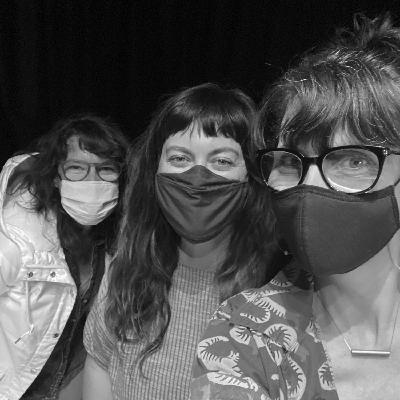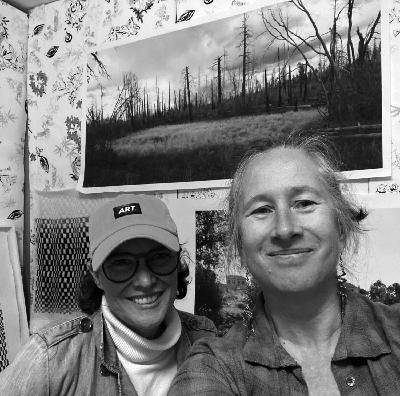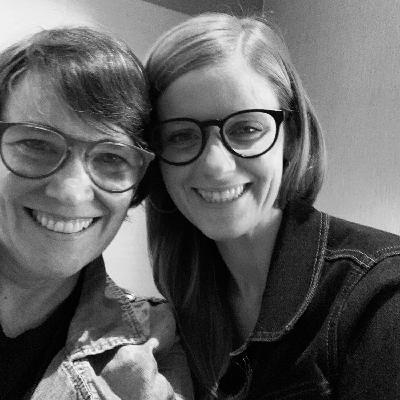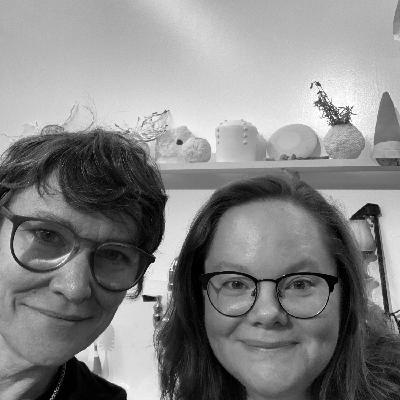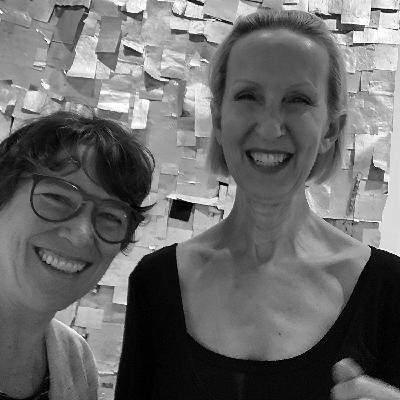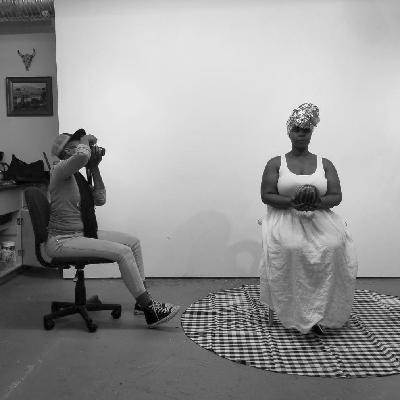Discover Peachy Keen
Peachy Keen

Peachy Keen
Author: Vivian Liddell
Subscribed: 3Played: 28Subscribe
Share
© Copyright Vivian Liddell
Description
Contemporary artist and native Southerner Vivian Liddell interviews women on art & the South. Bringing together women of all sorts to talk about their inspirations and definitions of art, and how these individual opinions reflect our changing region.
36 Episodes
Reverse
Leia Genis on her process:
The first half of the process— the cyanotypes—is really about building up
that information. I think of it like a riverbed depositing silt where it’s
like this constant kind of flow of information, and that leaves these small
deposits that build up on the bed. And then the second half of the process
where I’m dying it—It really feels like archeological, where I’m kind of
finding shapes or values or areas that I want to extract or to highlight or
to recolor to fit whatever image it is that I’m working towards.
Peachy Keen is back! Brushing the dust off our mics after a few years’ hiatus, we visited fellow Athens, Georgia artist Victoria Dugger in her studio at the Lyndon House Arts Center.We talked about our shared ties to Columbus, Georgia, flowers that eat bugs/horror/the “monstrous feminine,” the Atlanta art scene, self-imposed vs. societal expectations, and how she came to show at Sargent’s Daughters.Dugger showed us around her studio at the Lyndon House Arts Center, shared some behind the scenes information on the iconography in her work, and explained how she came to use gouache in her large-scale mixed media paintings.
Peachy Keen and guest co-host Stephanie Raines, artist advocate and arts administrator, visited Nashville-based artist Chalet Comellas-Baker in her artist-run exhibition space (Unrequited Leisure) just as all of us pandemic mole people were beginning to peep our little heads out of our burrows. Fittingly, after a year of not being with other humans, we talked about wildlife— particularly bird sounds as they relate to Comellas-Baker’s most recent artworks—and Nashville life among the honky-tonks (honky geese included!).Chalet shared the process behind her collaborative work with Clint Sleeper that’s currently on view at MOCAN, gave us really cute mini-zine maps that guided us through her current projects, and dropped some insider knowledge on the nuts and bolts of showing and getting paid for video work without using NFTs.
Peachy Keen masked-up and joined artist Alice Stone-Collins in her home studio in Atlanta, GA, for our first (and so far, only) pandemic interview. She contemplates the lasting impact that her rural Madison County upbringing has had on her work, which utilizes a combination of painting and collage techniques to depict a slightly askew, surreal version of the everyday mundane.We commiserate about pandemic life and motherhood as two working artist parents and get the low down on how the COVID-19 pandemic has and hasn’t affected the content of some of her most recent works. Stone-Collins explains how seemingly random or disjointed scenes such as carousel horses in a roundabout or a beach overrun with Amazon vans relate to her everyday experiences. She also talks about how My Little Pony “blank flanks” and “cutie marks” can sadly be seen as a metaphor for our society at large.
Peachy Keen met up with artist Jessica R. Smith at her home studio in Savannah, where she is a professor of fibers at the Savannah College of Art & Design. Smith is the is the co-author with Susan Falls of the recently released book Overshot: The Political Aesthetics of Woven Textiles from the Antebellum South and Beyond.We talked about her childhood spent between Alaska and Pennsylvania, her family’s history in the Florida panhandle, and how a formative backpacking trip around the world with a friend led her to a deeper appreciation of the use of textiles to create narratives.She explains how her artistic practice and research have evolved from an initial interest in painting and printmaking to a focus on performance and installations—starting with wallpaper and moving into fabrics. By playing as a designer and creating subtly subversive wallpapers that referenced historical designs (think 80s suburban angst meets Waverly prints) she became a designer—starting her own business and then licensing her designs to Studio Printworks.We discuss how her 12-year-relationship with SCAD colleague and professor of anthropology Susan Falls has led to multiple collaborations, culminating in their current book project, Overshot. Smith gives us the lowdown on their research process as a team, and some of the surprising finds they made as they explored the history, presentation, context and materiality of woven “overshot” coverlets.
Peachy Keen met up with artist Sonya Yong James on the occasion of her massive installation “Phantom Threads” as part of the PROJECT exhibition curated by Scott Ingram at the Temporary Art Center in Atlanta. (Thanks to our podcasting friends from Brainfuzz Podcast for lending us the use of their swank dedicated podcasting room on site!)We talked about our shared position as women/artists growing up in the 1970s/80s (shoulder pads did come up), her formative years in Stone Mountain, Georgia, and how she’s navigated labels as they pertain both to her art and her identity.She explains how the Gwisin of Korean folklore are related to her PROJECT piece, her path to working with such diverse materials as bedsheets and horsehair after having been initially trained as a printmaker and gives us the lowdown on managing a thriving studio practice that involves everything from supervising assistants to fear-free scissor lift operation.
Peachy Keen met up with artist Colleen Merrill on day three of SECAC 2019 and got into the nitty gritty of the psychology behind her conference presentation titled Mirroring: Affirming the Self as Parent, Artist, and Academic—discussing both Rozsika Parker and Donald Winnicott’s theories. We note the lack of men at parenting-related SECAC sessions and the importance of having men in the room when discussing parenting and career roles.But first, we talk about how she got sucked into the college town vortex of Lexington, Kentucky post grad school, seduced by its many charms—including the rich local craft community and cheap, easy access to an inspiring selection of found textiles. She paints a picture of how the local customs (like painted gourds for bird houses) have influenced her practice.She describes how her time at Residency Unlimited in Brooklyn made her realize how immense and popular textiles have become in the contemporary art scene, and we debate the extent of fiber-based mediums’ integration into the sometimes off-putting world of fine art. We also discuss parenthood and its relationship to her practice as an artist and her career as an academic. As a professor at a community college, Merrill explains how her initial naivety of her school’s policies on student parents worked in her favor as she works to build a more inclusive and supportive learning environment for her students with young children.
Peachy Keen met up with artist Naomi Falk in a boardroom at the Chattanoogan Hotel during the recent SECAC conference in Chattanooga, Tennessee. After briefly discussing some of the points that Falk made in her conference session on limits in the studio art classroom, we continued to talk about some of the challenges and joys of pushing students in our own classrooms, the long slog to a permanent teaching position in the arts, working collaboratively, and her experiences at artist residencies throughout the US and abroad.Originally from Michigan, Falk currently lives and works in South Carolina. We discussed how geography has affected her art practice—from a heightened awareness of climate change living in an area affected by hurricanes and frequent flooding, to her use of indigo, an important crop in the state during the eighteenth century.
Peachy Keen visited the home studio of Nashville artist Virginia Griswold on a Sunday morning to chat about her life and work. Starting with the shocking revelation that Griswold was once sent away to an all-girls Catholic school for disciplinary issues and a little family history focusing on women artists, we quickly get into tackling her broad-based postsecondary education.We discuss Griswold’s early focus on a variety of craft-related media and the related feminist overtones, her five years as a studio technician and instructor at Urban Glass in Brooklyn and her eventual choice to take a more conceptual direction in her work by attending graduate school at Alfred University’s Sculpture/Dimensional Studies program before getting into her current body of work.Sitting in her studio at a table of works in progress, we explore a variety of topics related to her materials, techniques and themes including combining fiber and ceramics, dyeing using native plants, and postpartem anxiety and the body. If you’re looking to get schooled on a wide variety of three-dimensional materials and techniques, this is your episode.
Brittainy Lauback on vacation cruises:We're always trying to vacation from ourselves and we never can. You know? What I think is so kind of disturbing about the cruise in general is that you have this—you know, you're really stuck with all these people. You really do kind of start to have like a little bit of an existential crisis. Like, you know, like hell is other peopleand you're stuck on the ship with them. And I really felt that, but at the same time I have to say I also felt this overwhelming tenderness. And like I also really loved all these people, and everyone was genuinelyopen and trying to connect. You know, it's like kind of those stereotypes about the…you know,open, loudmouth American. There's something really lovely about that.
Peachy Keen spent the morning at home talking art over coffee and pound cake with visiting curator, Rachel Reese. The kind of person that graduates from college ahead of schedule (3 ½ years, y’all!), Reese amassed an impressive resume of arts-related positions before landing in her current gig as Curator of Modern and Contemporary Art at Telfair Museums in Savannah.An Atlanta native, she shares some insights from her time at BURNAWAY and the Atlanta Contemporary. (Why would a digital art magazine want to do a print edition? Where did Sliver Space come from? This is your chance to find out.)We break down how Reese’s remarkable experiences working for big-name galleries like Deitch Projects in New York and Fleisher/Ollman in Philadelphia have translated (or not) into her career down South, share a few laughs at the expense of our well-meaning thrift store art shopping moms, and get the low down on the ins and outs of being a curator for the oldest public art museum in the South.
Peachy Keen met with artist and writer Donna Mintz in the back room of her exhibition at Sandler Hudson Gallery in Atlanta during the recent blackberry winter to talk about her current body of work. We discussed her use of materials to express ideas on memory and place: kaolin gathered from Georgia’s fall line recalls an ancient sea, elementary school milk cartons become a practical casting container for gold reliquaries, samples of water taken from North Georgia rivers and streams mark childhood haunts, and found large format negatives capture the gravitas of memory—even if those memories are unknown to us.
She gives us a detailed account of her 24 hours at a 1920s homesteaders’ cabin observing Walter De Maria’s masterwork, The Lightening Field, and explains how the concept of the sublime expressed in this work relates to her own art.
This is a good episode for you visual folks to bulk up on your literary to-do list because in addition to James Agee (who is featured with De Maria in Mintz’ current book in progress) Mintz references the works of many literary giants including Vladimir Nabakov, Ezra Pound, James Dickey, Lillian Smith, and Joel Chandler Harris. Also discussed: lost-cause mythology, the impermanence of human life, and generational gender roles.
Not all serious, we get a little silly with some chat about ASMR and maybe give you something to think about before you go whispering to the person next to you while an author is reading an emotional passage.
Peachy Keen met up with Christina Renfer Vogel in her Chattanooga studio to talk shop about her painting, teaching and curatorial projects. Originally from Pennsylvania, Vogel has been in Chattanooga for the past 6 years. We discussed her interim time in Nebraska working at the Bemis Center for Contemporary Arts, how she turned her office into an alternative exhibition space and the lingering benefits of going unplugged for a two-week summer residency at the Hambidge center.
Although working from life is a very traditional form of painting, Vogel explains how it remains new— energizing and surprising in its ability to slow us down. We talk about her artistic influences, her embrace of the heavy relationship painting has to art history and get some technical insights into her process as she prepares for two upcoming exhibitions.
In the spirit of the podcast, we blow up some hierarchies associated with painting beautiful, colorful still lifes. Painting flowers can be its own kind of bomb.
Katie Hargrave is an artist and educator in Chattanooga, Tennessee. Meredith Lynn is an artist and curator based in Tallahassee, Florida. Peachy Keen caught up with them in Chattanooga, where they were meeting up for the weekend to collaborate on a body of work for an upcoming exhibition at the Wiregrass Museum of Art that they first began exploring while at a Signal Fire residency in Oregon.
Artist Corrina Sephora moved to Atlanta in the mid 90s after receiving her BFA in Sculpture and Metalsmithing from the Massachusetts College of Art in Boston and has stayed on to become an integral player in the Atlanta arts community, establishing a prosperous artistic practice in metal and other media.
She tells Peachy Keen how she created her own apprenticeship program (looking up blacksmiths in the White Pages and refusing to take no for an answer), how local teachers and benefactors helped set her on the path to manage her own studio, and paints a picture of the gritty but thriving creative scene that was Atlanta in the 90s—when her neighbors included both artists (such as Radcliff Bailey and Danielle Roney) and guys that refurbished mac trucks.
We got into some discussion of how gender has and has not affected her trajectory in a career where women have been historically underrepresented, learned the ins and outs of moving a 3000 pound sculpture over a three story house, and covered some of the family backstory and artistic and cultural influences that play into her current exhibition: Between the Deep Blue Sea and the Universe.
Haylee Anne and Angela Bortone took a Twitter friendship to the next level, eventually joining forces with Jessica Caldas, Angela Davis Johnson, and Danielle Deadwyler to become the Living Melody Collective. This group of Atlanta-based, female-identifying artists is all about participating in and uplifting their community through creative projects.Peachy Keen chatted with Haylee Anne and Angela Bortone on a Saturday morning amongst Haylee Ann’s cat babies—who added a few sound effects for this episode. We discussed the group’s commitment to provide support to each other (especially as artist parents) and some of their individual backgrounds before getting into the nitty-gritty:How did they come up with the design for their mural at the Center for Civil and Human Rights? What’s the deal with the school bus that they painted and are using to promote voter engagement? Check out this episode to find out.
Artist Tommye Scanlin sat down with Peachy Keen at her loom in her Dahlonega, Georgia, studio to discuss teaching, learning, and tapestry on the eve of her second retirement from teaching. We got deep into the history of the University of North Georgia art department, where she taught for 28 years and was appointed Professor Emerita in 2002. Raised by a single mother, Scanlin attended college on scholarships and learned early on to balance her teaching career with her artistic practice. She described the role that her teacher, mentor, and then-colleague Bob Owens played in shaping her career, and she passed on some serious teaching wisdom centered on the desire to learn and the willingness to make mistakes.
Peachy Keen met up with artist Jenny Fine in the upstairs classroom of the Wiregrass Museum in Dothan, Alabama on a hot Friday afternoon in early October.
We discussed the influence that many strong creative women have had on her career—most notably that of her grandmothers (who both play an important role in her work) and of Ann Hamilton (a world-renowned installation artist who Fine studied under and then later apprenticed).
Fine elaborates on how her interest in the wet-collodion process and post-mortem photography is related to her “Flat Granny” series—which references the “Flat Daddy” photographic cutouts used by military families to help maintain a presence at home for deployed loved ones. We also get the lowdown on her performances and current stop motion film (link below) as they relate to her family history and her still photography.
In our talk, Fine explains how her personal narratives have allowed her to enter a larger discussion about white identity in the rural South, and we tiptoe into the minefield of racially charged regional iconography and customs depicted in her work that include the boll weevil, peanuts, and the pageantry of local parades and clogging.
Courtney Sanborn on medieval art and the iconography in her work:
Sanborn: Like I said, I love Medieval art. And I love the iconography. I
love that in that period of art …there’s no words to describe evil. How do
you describe something that’s evil or negative? There’s no words, but there
are pictures. And so, the artists of that time made their demons out
of—like there are these weird conglomerations—of like pigs, bats and like
weird creatures that they had like deemed evil. Right? And so that’s how
they portrayed the dark side of things. There’s always happy. There’s
always sad. There’s evil. There’s good. There’s temptation. There’s like
peace and like wholeness… and I love that they showed that. Cause I’ve
found that no matter what narrative or whatever situation I’ve found myself
in there’s always good. There’s always bad. And they exist together…
So, the demons in this embroidery are acting out the wedding rituals. She’s
getting her nails done. She’s getting her hair done. And down here, this is
the demon wedding. So this is the culmination of their day…which is
happening at the same time as my day.
Liddell: So there’s the flip—it’s like the yin-yang of weddings.
Sanborn: Yeah, yeah. So here’s this happy wedding that was happening…
here’s the garden party. These are my friends. And then here’s the demon
wedding that’s happening.
Liddell: Do the demons have their friends here?
Sanborn: They don’t have friends. It’s just them..
Peachy Keen began the school year with a visit to downtown Atlanta and the campus of Georgia State University to talk with artist Shanequa Gay in her studio.We discussed vulnerability and the importance of sharing the highs and the lows of life to pave the way for fledgling creatives. She accuses the women in her family of lying (not owning up to the fact that they were artists!), and admits to having her own kind of crazy, which has prompted her to steer clear of drugs and alcohol.She explains how her work as a spoken word poet is related to her performance art, and we specifically discuss her performance for Kathryn Johnston— a 92-year-old woman who was shot by police while inside her Atlanta home in 2006. She also gave us some background on the thought process behind her latest body of work, a photo series of African-American women.




